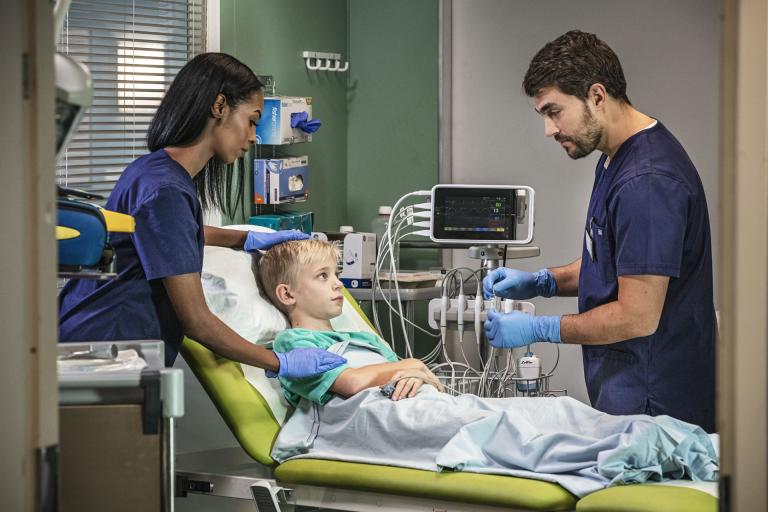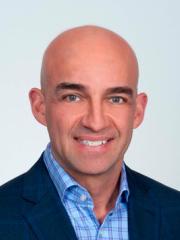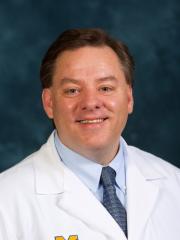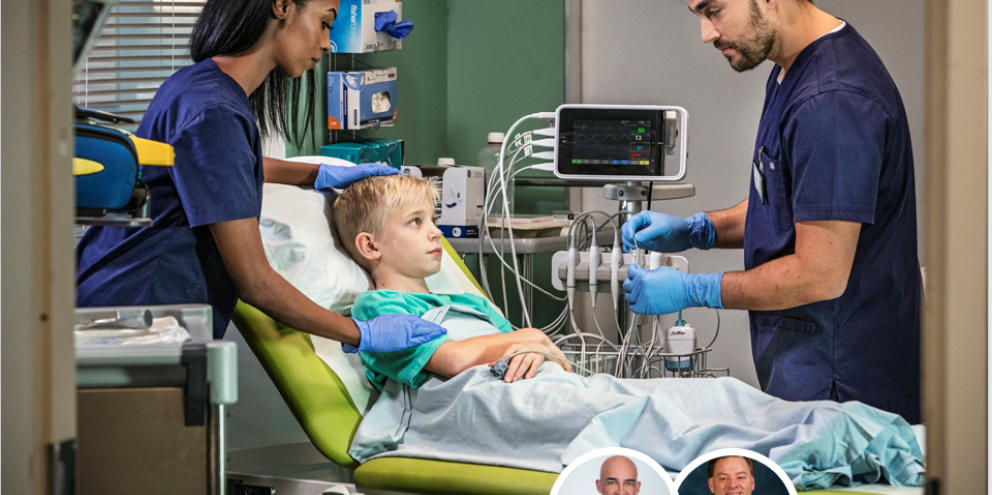
Part of the reason that spot-checks remain the standard of care is that digital technologies to enhance the monitoring process have not been widely implemented. But new wireless and wearable continuous patient monitoring tools are creating opportunities to improve patient care, reduce cognitive burden on clinicians, and drive economic advantages in medical-surgical, telemetry, and emergency departments (EDs).
To examine those opportunities in the ED, GE HealthCare interviewed Kyle Gunnerson, MD, a clinical professor in the Department of Emergency Medicine at the University of Michigan Medical School, and Robert Bilkovski, MD, president of RNB Ventures Consulting.
Q: Why has the practice of spot-checking patients’ vital signs become an area of focus in emergency departments?
Gunnerson: Most EDs are just hanging on for dear life. There's almost no monitoring in the ED waiting room and it's not hyperbole to say that people die there. Literally. People die waiting in the ED because they are overcrowded and operating on finite space and resources. At the same time, there are a lot of patients who are sick but not critical who are just waiting for those limited resources, and for a bed in the ED to become available. We really don’t have any way of monitoring them if they’re not hooked up to a bed — but it would be helpful to be able to monitor the people who might be deteriorating in ways spot checks do not identify in a timely manner so we can take appropriate action faster.
Bilkovski: We know that adherence to vital sign spot check monitoring is suboptimal. So continuously monitoring vital signs can help provide another layer of coverage by identifying deterioration earlier—that doesn't replace spot checks, but can serve as a safety net that augments the standard of care in three areas of the ED care continuum: prior to evaluation, the diagnostic and treatment phase to be able to make the ultimate decision of admit or discharge, and then boarding of patients who need to be admitted to the hospital.
Q: How can continuous vital sign monitoring augment the workforce and benefit clinicians?
Bilkovski: Doctors can't keep eyes on a patient at all times and have limited resources of nurses, patient care techs, and others so hospitals need ways to augment the emergency department staff.
Gunnerson: We might think a patient is relatively safe but there are gaps in care. So having the tools to identify deterioration of a given patient or demonstrate that a therapy is working, and improving patient monitoring with automation and reliable information, can effectively reduce the cognitive burden on clinical teams.
Q: What has changed in terms of technologies for continuously monitoring vital signs to advance patient care?
Bilkovski: The technology really wasn’t there before. Monitoring technologies available as recently as 2010 or even 2015 were very susceptible to artifact and at times inaccurate. But today’s wireless and wearable monitors are transformative because they collect and deliver more reliable data than spot-checks. Conventional spot-check monitoring almost always finds respiratory rate is 16 or 18 breaths per minute and is known to be imperfect. There’s value in continuous vital sign monitoring because a person’s respiratory rate is an early warning sign of adverse health events so clinical teams can address those earlier.
Gunnerson: Wireless and wearable technology that monitors heart rate and heart rhythm along with pulse oximetry and respiratory rate and that can prompt when an immediate evaluation is needed can be very useful in EDs. Since spot check monitoring is limited, I don’t think we need to wait for clinical evidence when it comes to wireless and wearable devices that reliably deliver accurate vital signs data.
Q: How would you advise a C-suite that is considering investing in continuous vital sign monitoring?
Gunnerson: In the last six months, look at how many people have been waiting in your ED. How many people have died in triage? How many code blues originated in triage? People present at the ER to have their life saved, not to die in the waiting room. Just show them the numbers to illustrate what you’re dealing with and it will become clear that the time has come to advance how we monitor patients to improve care.
Also, the technology can be used in the pre-triage or the triage environment, the treatment environment, the boarding environment, and then even transition upstairs to the inpatient environment too. It’s not a one-trick pony limited to the ED.
Bilkovski: That's right, there is also a front-end benefit because hospitals have gaps in triage. Boarding in the ED remains pervasive. Studies show that when looking at patients who board versus those who don't for the exact same diagnosis, those that board stay in a hospital longer and have worse outcomes. You can also build an argument that if you give everyone who is waiting for a bed a device that monitors their vital signs, that is adding a layer of security that may increase patient safety.
Q: How do you think about driving economic advantages with new technologies for continuous vital sign monitoring?
Gunnerson: To determine ROI, health systems and hospitals should conduct a deep dive into their records to build a clear picture of adverse events, near-misses, or patients incorrectly discharged or escalated into higher levels of acuity as markers of failed monitoring. Health systems have this data, and if they conduct that analysis, it will not be difficult to then enlist a champion to highlight that data, explain all the safety parameters, and advocate for improving vital sign monitoring to avoid as many of those adverse events as possible.
Bilkovski: Another one of the rates that would be helpful to show is decreasing length of stay. If you can shave a half day or a full day off from your admissions, that is huge. If a hospital gets paid for a three day stay by insurance or under the DRG, and they can safely discharges a patient in two days, the hospital will save some money and can move another patient into that bed sooner. So these are all bonuses. If you can prevent deterioration earlier in the ED rather than waiting to go upstairs, if you can prevent decompensation that's going to add an extra day or two onto a length of stay, these are going to significantly boost the bottom line.
This interview is part of our series examining how a new generation of continuous patient monitoring can streamline efficiencies and patient flow, help the clinician to improve patient care and ensure patient safety, reduce the cognitive burden on clinical teams, and drive economic advantages in medical-surgical, telemetry, and emergency departments. Our series also outlines the seven steps for C-suites managing the change to a culture of continuous patient monitoring.

Dr. Robert N. Bilkovski, MD, MBA
President, RNB Ventures Consulting Inc.
Dr. Bilkovski has broad management experience, having served in leadership roles in multiple Fortune 500 companies overseeing medical affairs and clinical development in IVD, medical device, and pharmaceuticals industries. Some of the companies where he served in leadership roles include Hospira, GE HealthCare, Abbott Laboratories, and Becton Dickinson. Robert currently is the President of RNB Ventures Consulting Inc. providing strategic consulting in the field of medical and clinical affairs for medical device and diagnostic companies.
Dr. Bilkovski received his undergraduate degree in biochemistry with a focus in genetic engineering at McMaster University in Hamilton, Ontario, Canada. Robert completed his medical training at Rosalind Franklin University/The Chicago Medical School and subsequently pursued specialization in emergency medicine. Lastly, Dr. Bilkovski earned his MBA at the University of Notre Dame as part of his transition from clinical medicine to medical industry.

Dr. Kyle Gunnerson
Professor of Emergency Medicine, Anesthesiology, and Internal Medicine/Critical Care
Dr. Gunnerson has been clinically active in both the Cardiovascular ICU and Emergency Department for more than 20 years. Dr. Gunnerson’s research includes several large collaborative projects funded by both industry and governmental funding agencies. These have ranged from the discovery and development of novel biomarkers in critical illness to the treatment of severe sepsis and septic shock. He has also been active in the development of non-invasive technology used for the identification and treatment of patients with critical illness and injury and was a co-investigator of the first ED based ECMO clinical trial for refractory cardiac arrest. Dr. Gunnerson was the inaugural Chief of the Division of Critical Care in the UM Department of Emergency Medicine and a founder of the Emergency Critical Care Center, the first ICU within an Emergency Department in the US. With extensive experience managing complex cardiac surgery patients and extracorporeal support, he has been instrumental in advancing Emergency Critical Care as a specialty and serves on the board of the Society of Critical Care Medicine.








